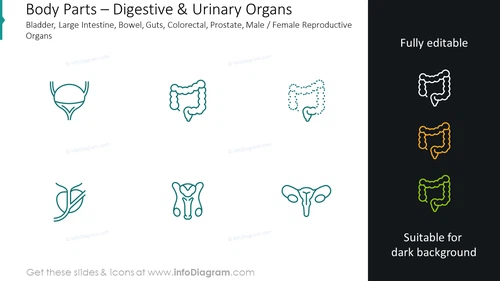Digestive and urinary organs: bladder, large intestine, bowel
from deck
Health Care, Medical Biology & Pharma Research Outline Icons (PPT icons)
- Info
- How To Edit
- Usage example
Info
Body Parts – Digestive & Urinary Organs
Slide Content
The PowerPoint slide represents a collection of icons associated with human anatomy, specifically focusing on digestive and urinary organs such as the bladder, large intestine, bowels, guts, colorectal area, and male/female reproductive organs. Each icon graphically represents an organ, simplified for visual clarity. The slide mentions that these representations are fully editable, suggesting they can be customized to fit various presentation needs. Furthermore, there is a note indicating that the icons are suitable for dark backgrounds, which alludes to design flexibility within presentations.
Graphical Look
- The slide background is a flat, dark color, providing high contrast for the lighter elements.
- There are eight icons centered in two rows and four columns, each depicting different body parts related to digestive and urinary systems.
- The icons are line drawings, minimalist in style, with each icon representing one organ system, and are composed of teal and white lines.
- The drawings of the organs are stylized rather than anatomically detailed, focusing on the most recognizable features of each organ.
- The title of the slide is placed at the top in a large, bold, white font which stands out against the dark background.
- An annotation in the upper right corner in smaller white text states "Fully editable."
- Another annotation in the lower right corner in smaller white text reads "Suitable for dark background."
- A pale blue decorative element is located on the left side of the slide, adding a slight touch of color and visual interest.
The slide is clean and modern, with a clear emphasis on the icons. The minimalist design ensures that the focus is on the content and message of the presentation.
Use Cases
- In a medical or healthcare presentation to explain the digestive and urinary systems.
- Within educational materials for students studying human anatomy or physiology.
- As part of training materials for healthcare professionals to visualize the location and relationships between different organs.
- Utilized in patient education to describe conditions or procedures related to the depicted body parts.
How To Edit
How to edit text & colors

How to expand / shorten diagram

How to Replace Icons in infoDiagram PPT


